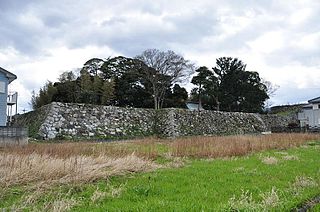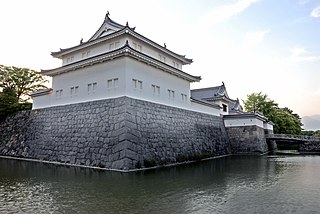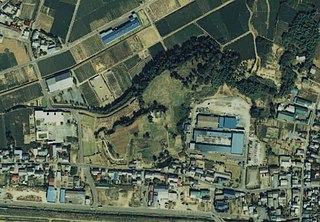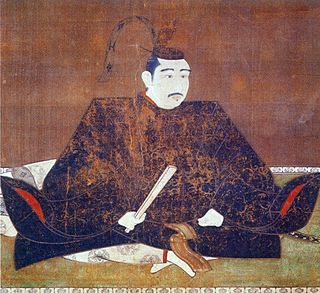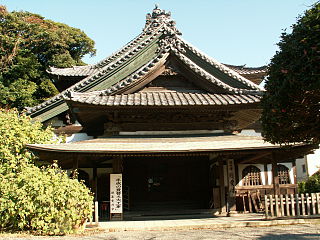
Sakai Tadayo(酒井 忠世, July 14, 1572 – April 24, 1636) was a Japanese daimyō of the Sengoku period, and high-ranking government advisor, holding the title of Rōjū , and later Tairō .

The daimyō were powerful Japanese feudal lords who, until their decline in the early Meiji period, ruled most of Japan from their vast, hereditary land holdings. In the term, dai (大) means "large", and myō stands for myōden(名田), meaning private land.
The Rōjū (老中), usually translated as Elder, was one of the highest-ranking government posts under the Tokugawa shogunate of Edo period Japan. The term refers either to individual Elders, or to the Council of Elders as a whole; under the first two shōguns, there were only two Rōjū. The number was then increased to five, and later reduced to four. The Rōjū were appointed from the ranks of the fudai daimyōs with domains of between 25,000 and 50,000 koku.
Tairō was a high-ranking official position in the Tokugawa shogunate government of Japan, roughly comparable to the office of prime minister. The tairō presided over the governing rōjū council in the event of an emergency. A tairō was nominated from among the fudai daimyōs, who worked closely with the Tokugawa traditionally. Generally, the office holder was the shogunate's chief policy maker, and provided Japan with a capable temporary leader in the absence of a shōgun, or in the event that the shōgun was incapacitated.
The son of Sakai Shigetada, Tadayo was born in Nishio, Mikawa Province; his childhood name was Manchiyo. He became a trusted elder (rōjū) in Toyotomi Hideyoshi's government, alongside Tokugawa Ieyasu. Under Hideyoshi, he was made lord of Kawagoe Castle (in Musashi Province, today Saitama Prefecture) and later of Nagoya Castle in Kyūshū's Hizen Province. In 1600, in the lead-up to the decisive Sekigahara campaign, he fought against the Tokugawa at Aizu, and submitted to them at the siege of Ueda. Thus, having joined the Tokugawa prior to the battle of Sekigahara itself, Sakai was made a fudai daimyō, and counted among the Tokugawa's more trusted retainers. He served under Ieyasu for a time, and under the second shōgun, Tokugawa Hidetada, as a hatamoto .
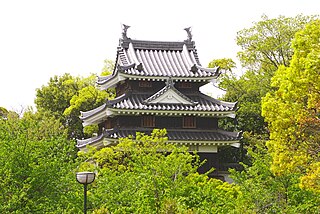
Nishio is a city located in Aichi Prefecture, in the Chūbu region of Japan. It is a regional commercial and manufacturing center and the country's leading producer of powdered green tea.

Mikawa Province was an old province in the area that today forms the eastern half of Aichi Prefecture. Its abbreviated form name was Sanshū. Mikawa bordered on Owari, Mino, Shinano, and Tōtōmi Provinces.
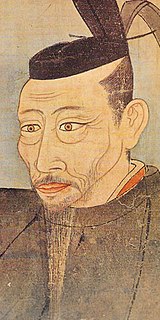
Toyotomi Hideyoshi was a preeminent daimyō, warrior, general, samurai, and politician of the Sengoku period who is regarded as Japan's second "great unifier". He succeeded his former liege lord, Oda Nobunaga, and brought an end to the Warring Lords period. The period of his rule is often called the Momoyama period, named after Hideyoshi's castle. After his death, his young son Hideyori was displaced by Tokugawa Ieyasu.
Sakai's father died in 1617, and so he inherited his father's domain of Maebashi in Harima Province, which had been assessed at 33,000 koku , and was now changed to 85,000 koku by the shogunate. In 1632, following a shakeup of positions within the bureaucracy, Sakai became nishi no maru rusui , placing him in charge of the western districts of Edo Castle, the seat of the shogunal government. Two years later, the Western districts were burnt down while the shōgun was away in Kyoto. Sakai was stripped of his position, and exiled to Kan'ei-ji.

Maebashi Domain was a feudal domain under the Tokugawa shogunate of Edo period Japan, located in Kōzuke Province, Japan. It was centered on Maebashi Castle in what is now part of the city of Maebashi, Gunma.

Harima Province or Banshū (播州) was a province of Japan in the part of Honshū that is the southwestern part of present-day Hyōgo Prefecture. Harima bordered on Tajima, Tanba, Settsu, Bizen, and Mimasaka Provinces. Its capital was Himeji.
The koku(石) is a Japanese unit of volume, equal to ten cubic shaku. In this definition, 3.5937 koku equal one cubic metre, i.e. 1 koku is about 278.3 litres. The koku was originally defined as a quantity of rice, enough rice to feed one person for one year. A koku of rice weighs about 150 kilograms.
Appealing to the Gosanke (the heads of the three branch families of the Tokugawa), Sakai was invited to return to the castle two years later, in 1636. Along with Doi Toshikatsu and Sakai Tadakatsu, he was appointed to the newly created post of Tairō (Great Elder). He died within weeks of being appointed, however, at the age of 64. His eldest son, Sakai Tadayuki, died around the same time, and so the next oldest son, Sakai Tadakiyo succeeded his father.
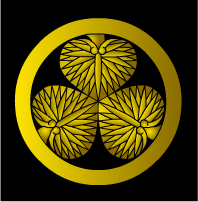
The Tokugawa Gosanke, also called simply Gosanke, or even Sanke, were the most noble three branches of the Tokugawa clan of Japan: Owari House of Tokugawa, Kii House of Tokugawa, and Mito House of Tokugawa, all of which were descended from clan founder Tokugawa Ieyasu's three youngest sons, Yoshinao, Yorinobu, and Yorifusa, and were allowed to provide a shōgun in case of need. In the Edo period the term gosanke could also refer to various other combinations of Tokugawa houses, including (1) the shogunal, Owari and Kii houses and (2) the Owari, Kii, and Suruga houses.

Doi Toshikatsu was a top-ranking official in Japan's Tokugawa shogunate during its early decades, and one of the chief advisors to the second Tokugawa shōgun, Hidetada.

Sakai Tadakatsu was a Sengoku period Japanese samurai, and early Edo period daimyō and served in several important positions within the administration of the Tokugawa shogunate.






